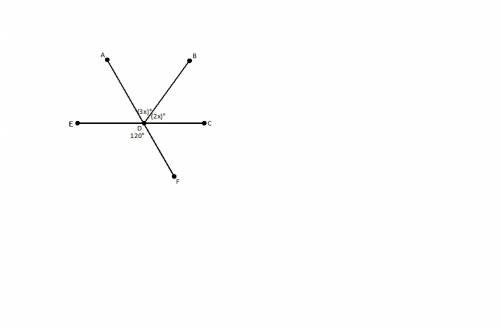 45
45 B: mAngle1 + mAngle2 = 90°
Step-by-step explanation:
Just took the test :D
 87
87 A. Inscribed angles theorem
Step-by-step explanation:
A.inscribed angles theorem
B.third corollary to the inscribed angles theorem
C.central angle of a triangle has the same measure as its intercepted arc.
D.Angle formed by a tangent and a chord is half the measure of the intercepted arc.
Just took the unit test on edgen and got 100
 74
74 " Vertical angles are congruent " ⇒ 2nd answer
Step-by-step explanation:
* Look to the attached figure
- There are three lines intersected at point D
- We need to find the missing in step 3
∵ Line FA intersects line EC at point D
- The angles formed when two lines cross each other are called
vertical angles
- Vertical angles are congruent (vertical angles theorem)
∴ ∠ADC and ∠FDE are vertical angles
∵ Vertical angles are congruent
∴ ∠EDF ≅ ∠ADC
∴ m∠EDF ≅ m∠ADC
∵ m∠EDF = 120° ⇒ given
∵ m∠ADC = m∠ADB + m∠BDC
∴ m∠ADB + m∠BDC = 120°
∵ m∠ADB = (3x)° ⇒ given
∵ m∠BDC = (2x)° ⇒ given
∴ 3x + 2x = 120 ⇒ add like terms
∴ 5x = 120 ⇒ divide both sides by 5
∴ x = 24
Column (1) Column (2)
m∠EDF = 120° given
m∠ADB = 3 x given
m∠BDC = 2 x given
∠EDF and ∠ADC are vertical angles defin. of vert. ∠s
∠EDF is congruent to ∠ADC vertical angles are
congruent
m∠ADC = m∠ADB + m∠BDC angle add. post.
m∠EDF = m∠ADC defin. of cong.
m∠EDF = m∠ADB + m∠BDC substitution
120° = 3 x + 2 x substitution
120 = 5 x addition
x = 24 division
∴ The missing reason is " vertical angles are congruent "
- From the explanation above ∠ADC and ∠FDE are vertical
angles then they are congruent according to vertical angle
theorem

 35
35  87
87 A. Inscribed angles theorem
Step-by-step explanation:
A.inscribed angles theorem
B.third corollary to the inscribed angles theorem
C.central angle of a triangle has the same measure as its intercepted arc.
D.Angle formed by a tangent and a chord is half the measure of the intercepted arc.
Just took the unit test on edgen and got 100
 74
74 " Vertical angles are congruent " ⇒ 2nd answer
Step-by-step explanation:
* Look to the attached figure
- There are three lines intersected at point D
- We need to find the missing in step 3
∵ Line FA intersects line EC at point D
- The angles formed when two lines cross each other are called
vertical angles
- Vertical angles are congruent (vertical angles theorem)
∴ ∠ADC and ∠FDE are vertical angles
∵ Vertical angles are congruent
∴ ∠EDF ≅ ∠ADC
∴ m∠EDF ≅ m∠ADC
∵ m∠EDF = 120° ⇒ given
∵ m∠ADC = m∠ADB + m∠BDC
∴ m∠ADB + m∠BDC = 120°
∵ m∠ADB = (3x)° ⇒ given
∵ m∠BDC = (2x)° ⇒ given
∴ 3x + 2x = 120 ⇒ add like terms
∴ 5x = 120 ⇒ divide both sides by 5
∴ x = 24
Column (1) Column (2)
m∠EDF = 120° given
m∠ADB = 3 x given
m∠BDC = 2 x given
∠EDF and ∠ADC are vertical angles defin. of vert. ∠s
∠EDF is congruent to ∠ADC vertical angles are
congruent
m∠ADC = m∠ADB + m∠BDC angle add. post.
m∠EDF = m∠ADC defin. of cong.
m∠EDF = m∠ADB + m∠BDC substitution
120° = 3 x + 2 x substitution
120 = 5 x addition
x = 24 division
∴ The missing reason is " vertical angles are congruent "
- From the explanation above ∠ADC and ∠FDE are vertical
angles then they are congruent according to vertical angle
theorem

 35
35  17
17 1. Which angles are adjacent.
CBX and FBC
Step-by-step explanation:
Okay so an adjacent angle is two angles with a common side. This means angles CBX and FBC are adjacent because they have the common side of "BC/CB"
Answer
2. Find the sum of the interior angles of a nonagon
1,260
Step-by-step explanation:
A nonagon is a 9 sided polygon with angles of 140. It wants the sum of all the angles. Since it has 9 sides, it has 9 angles. Now you can add 140, 9 times, or do 140 x 9. This gets you 1,260.
Answer
3. The measure of angle 3 is 101. find the measure of angle 4.
79
Step-by-step explanation.
Okay so both angles are against the same intersecting line, this means their sum must be 180. All we have to do here is subtract 180 and 101. this gets us 79.
Answer
4. Find the measure of each interior angle of a regular polygon with 12 sides.
1800
Step-by-step explanation.
Okay so a 12 sided regular polygon is a dodecagon. This has 12 angles with the degree of 150. This means 150 x 12 just like the 2nd question about nonagons. So 150 x 12 is 1800
Now that i've showed you how to do the first 4 you can apply the rest of the information on your own for 5 and the rest of the test.
 23
23 C the answer is C
Step-by-step explanation:
 17
17 Option C The measure of angle CAB = The measure of angle C prime A prime B prime
Step-by-step explanation:
we know that
The transformation of the figure is a reflection, so after the transformation the shape still has the same size, area, angles and line lengths.
the triangles ABC and A'B'C' are congruent
therefore
the corresponding sides and corresponding angles are equal
so
The relationship between the measures of the angles of the two triangles is


 -----> the solution
-----> the solution

It will provide an instant answer!
